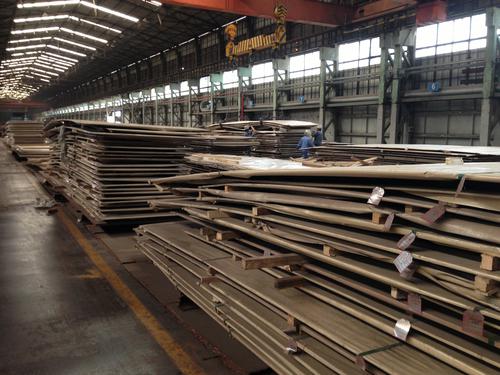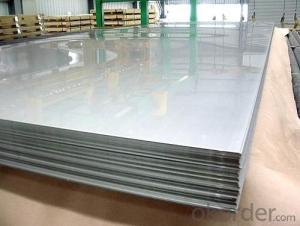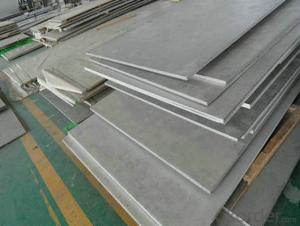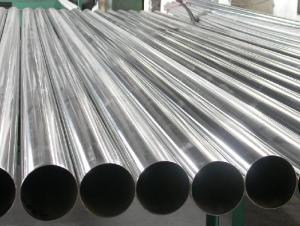stainless steel plate stocks 201
- Loading Port:
- Tianjin
- Payment Terms:
- TT OR LC
- Min Order Qty:
- -
- Supply Capability:
- 5000 m.t./month
OKorder Service Pledge
Quality Product, Order Online Tracking, Timely Delivery
OKorder Financial Service
Credit Rating, Credit Services, Credit Purchasing
You Might Also Like
grade | 201,301,304,310,316,410,420,430,etc. |
surface | 2B,NO.1, NO.4, Mirror, Hairline, etc. |
thickness | 1MM, |
width | 1200MM,1220MM,1500MM,ETC. |
length | 2400MM,2440MM,3000MM,ETC. |
Payment terms | T/T, or L/C. |
Delivery time | Normally within 1 weeks after get your deposits. |
package | Standard export package, normally with wooden pallets |
MOQ | 5 tons/each size |
We have the best-quality stainless steel sheet/coil,etc.
with the shortest deliverytime, etc.
- Q: Can stainless steel sheets be used in high-temperature environments?
- Yes, stainless steel sheets can be used in high-temperature environments. Stainless steel has excellent heat resistance properties, including high melting point and oxidation resistance, making it suitable for applications in high-temperature environments such as industrial furnaces, boilers, and exhaust systems.
- Q: What's the price of 06cr19ni10 and 304 stainless steel?
- In order to maintain the inherent corrosion resistance of stainless steel, steel must contain more than 16% chromium, more than 8% of the nickel content. 304 stainless steel is a brand of stainless steel produced according to the ASTM standard in the United states.
- Q: What are the fire resistance properties of stainless steel sheets?
- Stainless steel sheets have excellent fire resistance properties due to their high melting point and low thermal conductivity. They can withstand high temperatures without losing their structural integrity, making them suitable for use in fire-resistant applications.
- Q: How do I prevent discoloration on stainless steel sheets?
- To avoid discoloration on stainless steel sheets, there are several steps you can take: 1. Keep them clean: Make sure to clean stainless steel sheets on a regular basis using mild soap or a dedicated stainless steel cleaner. Steer clear of abrasive cleaners or scrub brushes, as they can scratch the surface and make it more susceptible to discoloration. 2. Steer clear of harsh chemicals: Avoid using harsh chemicals, bleach, or cleaners containing chlorine on stainless steel sheets, as they can lead to discoloration. If any spills occur, clean them up immediately to prevent staining. 3. Ensure proper ventilation: It is crucial to have adequate ventilation in the area where the stainless steel sheets are installed. This is particularly important in spaces where chemicals or fumes are present, as they can react with the stainless steel and cause discoloration. 4. Apply protective coatings: Consider applying a protective coating to the stainless steel sheets to help prevent discoloration. There are various protective coatings available on the market that are specifically designed for stainless steel. These coatings create a barrier between the steel and external factors, reducing the likelihood of discoloration. 5. Perform regular maintenance: Regularly inspect the stainless steel sheets for any signs of discoloration or damage. Address any issues promptly to prevent further deterioration. By implementing these preventive measures, you can reduce the risk of discoloration on stainless steel sheets and maintain their aesthetic appeal for an extended period of time.
- Q: Can stainless steel sheets be used for restaurant equipment?
- Certainly! Restaurant equipment can indeed utilize stainless steel sheets. Stainless steel is a highly favored option for restaurant equipment owing to its multitude of advantages. Its durability, resistance to corrosion, and ease of cleaning all contribute to its popularity. By employing stainless steel sheets, restaurant equipment can be crafted into diverse forms and dimensions, fulfilling the particular needs of countertops, sinks, tables, shelves, and food preparation surfaces. Moreover, stainless steel is an exceptionally hygienic substance that does not interact with food or taint it, rendering it perfect for deployment in restaurant environments where cleanliness and food safety are of utmost importance.
- Q: How can I classify stainless steel plates?
- Stainless steel plate steel according to the histological classification, can be divided into: Austenitic (200 series, 300 series stainless steel), austenite ferrite (both austenite and ferrite stainless steel body) and ferrite (409, 430, 434 series stainless steel) and martensite (403, 410, 414, 416.).
- Q: Can stainless steel sheets be used for outdoor signage?
- Yes, stainless steel sheets can be used for outdoor signage. Stainless steel is a durable and corrosion-resistant material that can withstand harsh weather conditions and maintain its appearance over time. It is commonly used in outdoor signage due to its ability to resist rust, fading, and damage from exposure to sunlight, rain, snow, and other environmental elements. Additionally, stainless steel sheets can be customized with various finishes, such as brushed or polished, to enhance their visual appeal and make them suitable for any outdoor signage application.
- Q: What does stainless steel plate mean?
- Stainless steel plate, the surface of the board is bright and clean, with high plasticity, toughness and mechanical strength, acid, alkaline gas, solution and other media corrosion. It is an alloy steel which is not easily rusted, but it is not absolutely rusty. Stainless steel plate refers to the atmosphere, steam and water and other weak medium corrosion of steel plate, and acid resistant steel plate refers to acid, alkali, salt and other chemical corrosive medium corrosion of steel plate. Stainless steel plate has been published since the beginning of twentieth Century, and now has a history of more than 1 centuries.
- Q: What about black titanium stainless steel?
- A black titanium stainless steel plate in recent years a large number of signs used in industry (the back of the board also has some kind of black ash), not the actual titanium plate, the layer of black and no titanium metal components, stainless steel should be black.
- Q: What are the different types of stainless steel sheet edge treatments available?
- Various edge treatments are available for stainless steel sheets, each offering distinct advantages and aesthetic options. 1. The mill edge treatment is the most commonly used, where the stainless steel sheet is produced with an unfinished, straight edge. It is cost-effective and suitable for applications that prioritize functionality over appearance. 2. The slit edge treatment involves cutting the stainless steel sheet to the desired width, resulting in a smooth edge. Slit edge sheets are commonly used in industries like food processing and pharmaceuticals, where a clean, burr-free finish is necessary. 3. The deburred edge treatment focuses on removing any burrs or sharp edges from the stainless steel sheet, leaving a smooth and safe edge. It is often employed in architectural or automotive applications where safety is a concern. 4. The rolled edge treatment involves bending the stainless steel sheet to create a rounded edge. This treatment is popular in applications where safety and aesthetics are important, such as kitchen appliances or decorative pieces. 5. The beveled edge treatment refers to cutting the stainless steel sheet at an angle, creating a diagonal edge. Beveled edges are commonly used in architectural applications to achieve a smooth transition between different materials or enhance the overall design. These examples illustrate the range of stainless steel sheet edge treatments available. The choice of treatment depends on specific application requirements, including functionality, safety, and aesthetics.
Send your message to us
stainless steel plate stocks 201
- Loading Port:
- Tianjin
- Payment Terms:
- TT OR LC
- Min Order Qty:
- -
- Supply Capability:
- 5000 m.t./month
OKorder Service Pledge
Quality Product, Order Online Tracking, Timely Delivery
OKorder Financial Service
Credit Rating, Credit Services, Credit Purchasing
Similar products
Hot products
Hot Searches
Related keywords
























